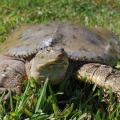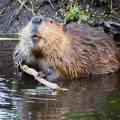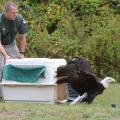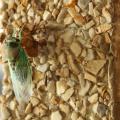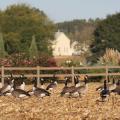Extension Outdoors from 2015
It’s that time of year when medical experts recommend we all get flu shots to minimize the chance of influenza causing us to get really sick or, in extreme cases, even die. Believe it or not, wildlife can get the flu, too.
STARKVILLE, Miss. -- Often found scavenging in trash cans or seen lying dead on roadsides after car collisions, opossums are not the most revered or understood wildlife creatures in Mississippi.
Ray Iglay, Certified Wildlife Biologist
MSU Department of Wildlife Fisheries and Aquaculture
STARKVILLE, Miss. -- As creatures of habit, our lives follow patterns.
We go to sleep at night, wake in the morning, get ready for work and run out the door. Throughout the year, school and work schedules, and even holiday seasons, structure our annual cycles of activities. Across decades, we may even mark life achievements, such as starting to crawl as an infant or achieving retirement.
While dressing a deer this fall, there are some common parasites you may encounter. None of these parasites actually affects the quality of the deer meat, but it is important to recognize what they are.
Louse flies…
Have you ever noticed little wingless critters crawling around on a deer’s belly? Those are louse flies -- also called deer keds. The adult flies shed their wings and become flightless. While at first glance louse flies resemble small ticks, they only have six legs.
Often, the person is concerned that turtles are eating his fish. Sometimes the turtles are eating the pond owner’s fish food. Other times, the caller has caught a turtle while catfishing and does not like dealing with the angry reptile on the end of his line. For one reason or another, turtles have a bad reputation in Mississippi ponds. Well, it is time to set the record straight on turtles!
STARKVILLE, Miss. -- For an unassuming rodent, the beaver has quite a significant place in American history.
For more than 300 years, the beaver was one of the most valuable fur-bearing animals in North America and drove the fur trade, one of the earliest and most important industries in the development of the United States and Canada.
STARKVILLE, Miss -- It’s a duck, it’s a goose...no, it’s a Cormorant?
The double-crested cormorant is a 4- to 6-pound bird with black or dark plumage. Often cormorants are mistaken for common waterfowl because they are seen swimming on ponds and lakes throughout Mississippi from late fall to early spring. Cormorants migrate each year from the Great Lakes region of the U.S. and Canada to spend their winters on the warm waters of the South. They really are snow birds!
STARKVILLE, Miss. -- Wild animals are amazing for many reasons. Whether it’s flying high in the sky, singing beautiful songs or simply displaying the amazing colors and patterns of their feathers or fur, wild creatures attract people. So, when we come upon an injured or sick animal, in most cases, we want to help it any way possible.
STARKVILLE, Miss. -- So, you have finally worked up the nerve to ask that landowner for permission to hunt his property for the upcoming hunting season, and he said yes.
STARKVILLE, Miss. -- “Birds of a feather . . .” Can you finish this sentence?
If you answered, “birds of a feather flock together,” you would be right. Wild animals are part of American culture, found in our literature, art and sports team names. Even for those who do not hunt, fish or live in wild places, wildlife may be a part of their lives.
STARKVILLE, Miss. -- While many humans anticipate making certain changes with the arrival of a new year, certain insects have much different life cycles.
Periodical cicadas may anticipate emerging from the ground in 2016, while others may simply have to wait a few more years to see the light of day.
Cicadas are curious creatures. From beady eyes on the sides of their heads to prominent veins stretching across their glassy wings, they seem to be created from the Twilight Zone. Yet, they produce one the most common sounds of summer.
STARKVILLE, Miss. -- Winter months bring short days of weak sunlight, cold nights and icy rain. Even though Southern states have relatively mild winters, the more extreme weather conditions make life more difficult.
We humans hide indoors in furnace-warmed air, put on layers of clothing to combat the chill and use insulated coats, hats and gloves when forced to go outside. But what about the creatures that live outdoors? How do they survive until spring’s warm breezes and sunshine once again return?
Pages
- « first
- ‹ previous
- 1
- 2
- 3




